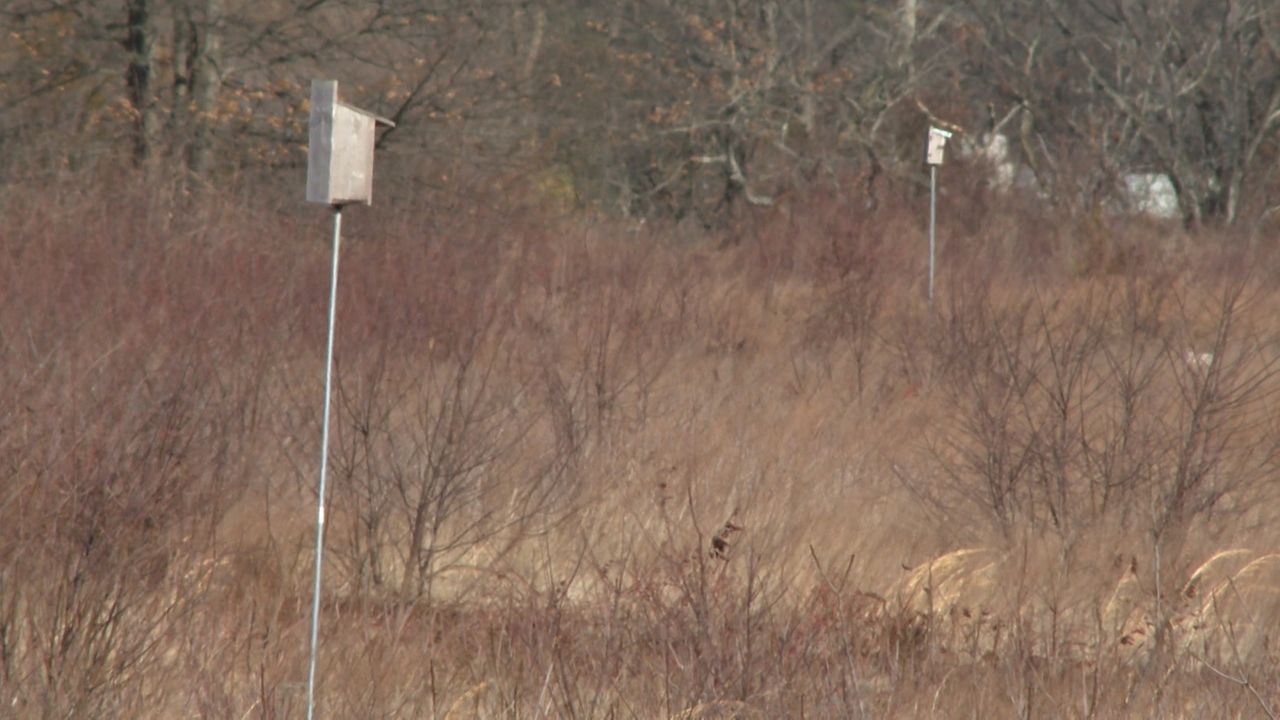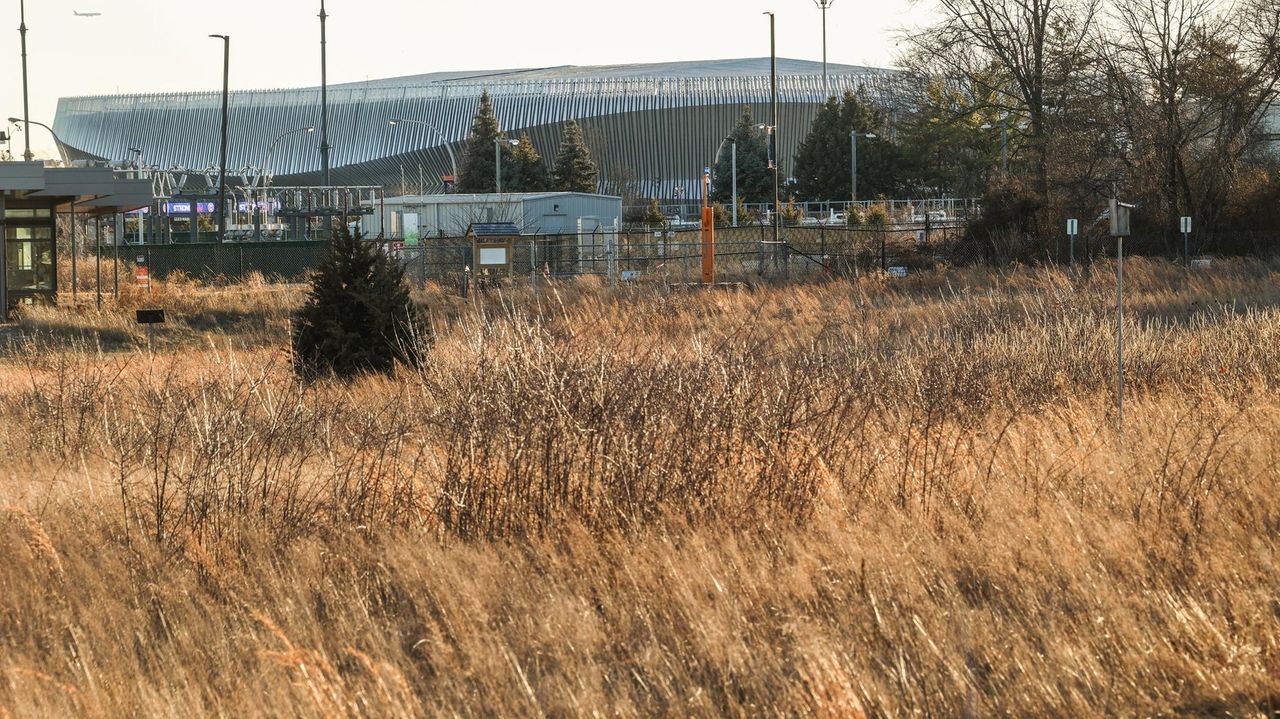Tucked among the malls, parkways and office buildings of central Nassau County is 100 acres of natural habitat for birds, insects and threatened plant species resembling a prairie in the Midwest.
The rare, county-owned grasslands sit adjacent to another county-owned site: The 72-acre, asphalt property of the Nassau Veterans Memorial Coliseum where the Las Vegas Sands has proposed a $6 billion casino-resort.
Environmental groups are now calling on county leaders and the Nevada-based company to come up with a plan to protect bird migration patterns and the rare animals on the land from the resort’s lighting and water usage.
“There are 50 species that live here all year-round and there are about 50 species that also nest here during the summer and there’s hundreds of species that move through on their way north and south during the migrations,” said Russell Comeau, president of the South Shore Audubon Society, based in Freeport.
Scientists say the plains spanned 40,000 acres when Long Island was formed out of glaciers. The last remaining parcels are among the most ecologically and historically significant county-owned land, they say, worthy of a plan to buffer the effects of the proposed Sands development.
The project — which includes a 400,000-square-foot casino, two hotels, a convention center, retail and dining areas — requires a development lease from Nassau County, land-use approvals from the Town of Hempstead and a competitive gaming license from New York State.
The company, which has spent more than a year reaching out to local environmental groups, released a statement in response to Newsday’s questions on how they would address the Hempstead Plains, saying it has “a long, well-documented history of environmental achievements and excellence in both development and operations at all our properties worldwide.”
While traffic and water usage have been at the top of the list of community concerns about the project, a renewed effort to restore and permanently preserve is gaining momentum as county lawmakers are in the throes of a multistep, state-mandated environmental review known at SEQRA.
The 19-member county legislature is collecting written public comment before a Jan. 21 deadline on an over 28,000-page draft environmental impact statement — one step in the lengthy approval process before submitting an application to the state by June.
Comeau’s group is among those working on its submission to the legislature, asking that the final version of the project’s environmental impact statement specifically include protections for the animal and plant species who rely on that open space.
Threatened birds such as the upland sandpiper and the grasshopper sparrow used to nest regularly on the ground of the Hempstead Plains. Others, such as the eastern meadow lark, are on the state’s list of “special concern.”
An effort to build the Sands project with little light disruption to the wildlife there and restoring the land to help bring back some of the endangered species would be ideal, environmentalists say. Artificial light disrupts the natural habitat and keeps trees from growing and altering behaviors and breeding cycles for animals.
Comeau said “the real threat” to the habitat from the project is the amount of water drawn from the aquifer and water runoff from the resort that could pollute the streams, rivers and wetlands of the Purcell Preserve and the East Meadow Brook riparian corridor, subsections of the Hempstead Plains where the grasslands and northeast coastal terrain meet.
Joining him on this effort is the North Shore Land Alliance, a Mill Neck-based nonprofit land trust that owns and maintains 14 nature preserves on Long Island.
“There is a big opportunity there,” said Lisa Ott, the group’s president.
Like the South Shore Audubon Society, the North Shore Land Alliance isn’t opposed to the project and has applauded Sands’ environmental outreach.
“Everyone’s come to terms that something will be built there,” Ott said. But she also noted: “There isn’t a lot of open space left in western Long Island and what’s left of it is critical to a healthy future.”
There’s about 10,000 acres of “environmentally significant” open space worthy of protection in Nassau county, Ott said.
Ideally, the communities around the Coliseum site would come together to advocate for a detailed plan for the land’s preservation, perhaps encourage some public use and education.
Ott said she believed Sands has a track record of “environmentally responsible” development and in meetings with environmental groups had indicated they would be interested in restoring and preserving the Hempstead Plains area.
“This is a habitat that is so historically significant to this particular part of the world. The 100 acres really should be protected and set aside as native grasslands — the world needs it, biodiversity needs it but most of all our children need it. It can be an outdoor classroom,” Ott said.
Mary Studdert, spokeswoman for the county legislature’s Republican majority, said lawmakers and their consultants “are reviewing the public comment from the environmental review process and the Final Environmental Impact Statement (FEIS) will address the concerns that were raised regarding the Hempstead Plains.”
Legis. Delia DeRiggi-Whitton, who leads the Nassau’s Democratic caucus, said she is encouraging others on the county legislature to set aside community benefits money to help restore and maintain the land with the hope that it can be enjoyed by the public.
“As part of Nassau County’s ‘Perpetual Preservation Plan,’ we have both a moral and legal responsibility to protect the integrity of the existing Preserve. This commitment to preservation reflects our dedication to environmental stewardship and sustainable development, ensuring that our natural resources remain safeguarded for the health and well-being of both our community and the planet,” said DeRiggi-Whitton (D-Glen Cove).
The DEIS details the measures Sands intends to implement for the project on the 72-acre Coliseum site in Uniondale. The public document, available on Nassau County’s website, includes Sands’ plans to expand the Meadowbrook Parkway and build a new underground well that would draw nearly 2 million gallons of water per day from the Island’s aquifer.
The report was prepared by VHB Engineering, Surveying, Landscape, Architecture and Geology, P.C in Hauppauge and presented publicly in November.
County legislators held an in-person public hearing Dec. 9 in Mineola that drew hundreds of speakers.
A spokesman for Sands noted the company’s listing on the Dow Jones Sustainability Index and said “as part of the State and County approval process, all submitted comments will be addressed in the Final Environmental Impact Statement.”
“We look forward to continuing to collaborate with Long Island’s environmental community to create a LEED-certified world-class resort that provides new entertainment, jobs, and opportunity in the most sustainable way,” the statement said.
Adrienne Esposito, executive director of Citizen Campaign for the Environment, based in Farmingdale, said she has always looked at the project while asking herself one question: “Is this development more or less environmentally sensitive than something else that might be developed there?”
Esposito, who has watched two decades of failed development at the Coliseum property, said her group was impressed by Sands’ plan to recycle some of the non-potable water it uses on-site but remains concerned about water drawn from the aquifer and her written comments address light pollution and protecting the Hempstead Plains.
“If the county owns the property, the county should be spearheading a preservation and management process with the local groups that have the expertise on the local ecology. And the county can take the opportunity to use some of the community benefits from the Sands project. That would be a great use of the funds and a great benefit to the community. But they can’t expect the developer to protect land they don’t own or they aren’t using,” Esposito said.
Tucked among the malls, parkways and office buildings of central Nassau County is 100 acres of natural habitat for birds, insects and threatened plant species resembling a prairie in the Midwest.
The rare, county-owned grasslands sit adjacent to another county-owned site: The 72-acre, asphalt property of the Nassau Veterans Memorial Coliseum where the Las Vegas Sands has proposed a $6 billion casino-resort.
Environmental groups are now calling on county leaders and the Nevada-based company to come up with a plan to protect bird migration patterns and the rare animals on the land from the resort’s lighting and water usage.
“There are 50 species that live here all year-round and there are about 50 species that also nest here during the summer and there’s hundreds of species that move through on their way north and south during the migrations,” said Russell Comeau, president of the South Shore Audubon Society, based in Freeport.
Scientists say the plains spanned 40,000 acres when Long Island was formed out of glaciers. The last remaining parcels are among the most ecologically and historically significant county-owned land, they say, worthy of a plan to buffer the effects of the proposed Sands development.
The players
The project — which includes a 400,000-square-foot casino, two hotels, a convention center, retail and dining areas — requires a development lease from Nassau County, land-use approvals from the Town of Hempstead and a competitive gaming license from New York State.
The company, which has spent more than a year reaching out to local environmental groups, released a statement in response to Newsday’s questions on how they would address the Hempstead Plains, saying it has “a long, well-documented history of environmental achievements and excellence in both development and operations at all our properties worldwide.”
While traffic and water usage have been at the top of the list of community concerns about the project, a renewed effort to restore and permanently preserve is gaining momentum as county lawmakers are in the throes of a multistep, state-mandated environmental review known at SEQRA.
The 19-member county legislature is collecting written public comment before a Jan. 21 deadline on an over 28,000-page draft environmental impact statement — one step in the lengthy approval process before submitting an application to the state by June.
Comeau’s group is among those working on its submission to the legislature, asking that the final version of the project’s environmental impact statement specifically include protections for the animal and plant species who rely on that open space.
Threatened birds such as the upland sandpiper and the grasshopper sparrow used to nest regularly on the ground of the Hempstead Plains. Others, such as the eastern meadow lark, are on the state’s list of “special concern.”
An effort to build the Sands project with little light disruption to the wildlife there and restoring the land to help bring back some of the endangered species would be ideal, environmentalists say. Artificial light disrupts the natural habitat and keeps trees from growing and altering behaviors and breeding cycles for animals.
Comeau said “the real threat” to the habitat from the project is the amount of water drawn from the aquifer and water runoff from the resort that could pollute the streams, rivers and wetlands of the Purcell Preserve and the East Meadow Brook riparian corridor, subsections of the Hempstead Plains where the grasslands and northeast coastal terrain meet.
Joining him on this effort is the North Shore Land Alliance, a Mill Neck-based nonprofit land trust that owns and maintains 14 nature preserves on Long Island.
“There is a big opportunity there,” said Lisa Ott, the group’s president.
Like the South Shore Audubon Society, the North Shore Land Alliance isn’t opposed to the project and has applauded Sands’ environmental outreach.
“Everyone’s come to terms that something will be built there,” Ott said. But she also noted: “There isn’t a lot of open space left in western Long Island and what’s left of it is critical to a healthy future.”
There’s about 10,000 acres of “environmentally significant” open space worthy of protection in Nassau county, Ott said.
Combining efforts
Ideally, the communities around the Coliseum site would come together to advocate for a detailed plan for the land’s preservation, perhaps encourage some public use and education.
Ott said she believed Sands has a track record of “environmentally responsible” development and in meetings with environmental groups had indicated they would be interested in restoring and preserving the Hempstead Plains area.
“This is a habitat that is so historically significant to this particular part of the world. The 100 acres really should be protected and set aside as native grasslands — the world needs it, biodiversity needs it but most of all our children need it. It can be an outdoor classroom,” Ott said.
Mary Studdert, spokeswoman for the county legislature’s Republican majority, said lawmakers and their consultants “are reviewing the public comment from the environmental review process and the Final Environmental Impact Statement (FEIS) will address the concerns that were raised regarding the Hempstead Plains.”
Legis. Delia DeRiggi-Whitton, who leads the Nassau’s Democratic caucus, said she is encouraging others on the county legislature to set aside community benefits money to help restore and maintain the land with the hope that it can be enjoyed by the public.
“As part of Nassau County’s ‘Perpetual Preservation Plan,’ we have both a moral and legal responsibility to protect the integrity of the existing Preserve. This commitment to preservation reflects our dedication to environmental stewardship and sustainable development, ensuring that our natural resources remain safeguarded for the health and well-being of both our community and the planet,” said DeRiggi-Whitton (D-Glen Cove).
The DEIS details the measures Sands intends to implement for the project on the 72-acre Coliseum site in Uniondale. The public document, available on Nassau County’s website, includes Sands’ plans to expand the Meadowbrook Parkway and build a new underground well that would draw nearly 2 million gallons of water per day from the Island’s aquifer.
The report was prepared by VHB Engineering, Surveying, Landscape, Architecture and Geology, P.C in Hauppauge and presented publicly in November.
County legislators held an in-person public hearing Dec. 9 in Mineola that drew hundreds of speakers.
The long bet
A spokesman for Sands noted the company’s listing on the Dow Jones Sustainability Index and said “as part of the State and County approval process, all submitted comments will be addressed in the Final Environmental Impact Statement.”
“We look forward to continuing to collaborate with Long Island’s environmental community to create a LEED-certified world-class resort that provides new entertainment, jobs, and opportunity in the most sustainable way,” the statement said.
Adrienne Esposito, executive director of Citizen Campaign for the Environment, based in Farmingdale, said she has always looked at the project while asking herself one question: “Is this development more or less environmentally sensitive than something else that might be developed there?”
Esposito, who has watched two decades of failed development at the Coliseum property, said her group was impressed by Sands’ plan to recycle some of the non-potable water it uses on-site but remains concerned about water drawn from the aquifer and her written comments address light pollution and protecting the Hempstead Plains.
“If the county owns the property, the county should be spearheading a preservation and management process with the local groups that have the expertise on the local ecology. And the county can take the opportunity to use some of the community benefits from the Sands project. That would be a great use of the funds and a great benefit to the community. But they can’t expect the developer to protect land they don’t own or they aren’t using,” Esposito said.






